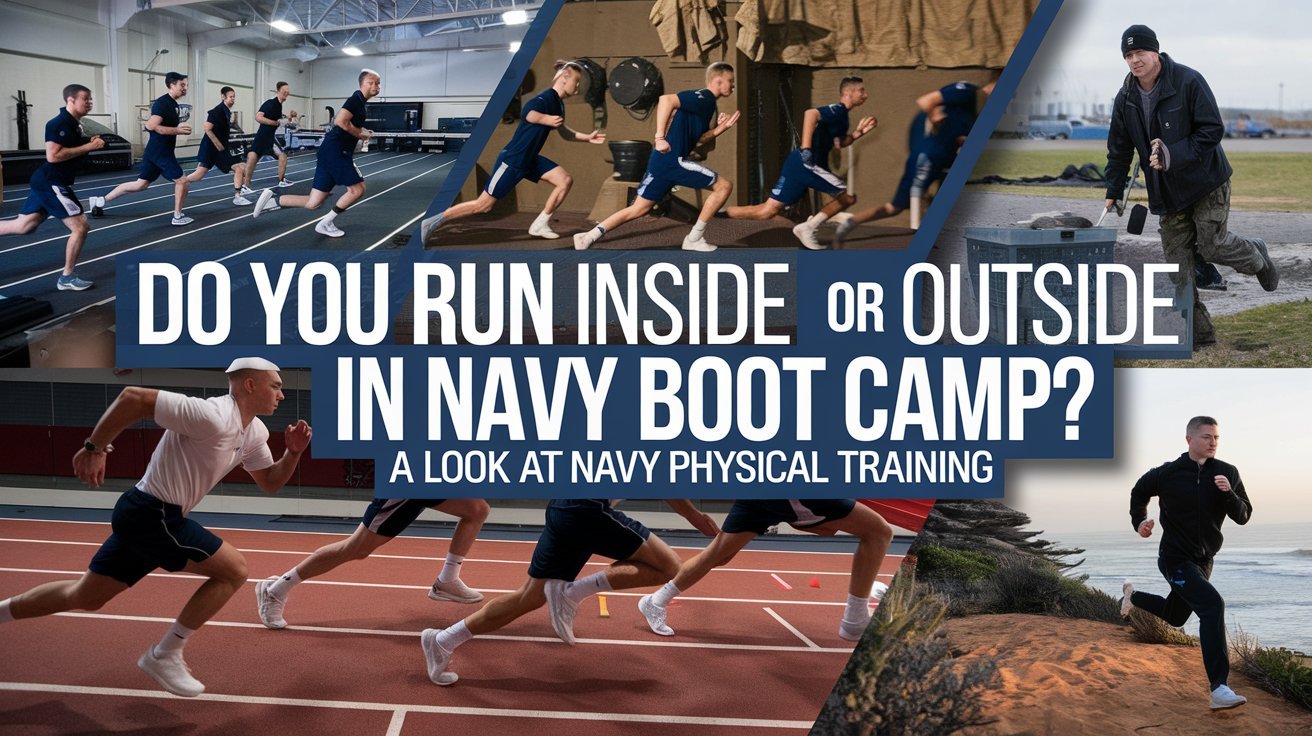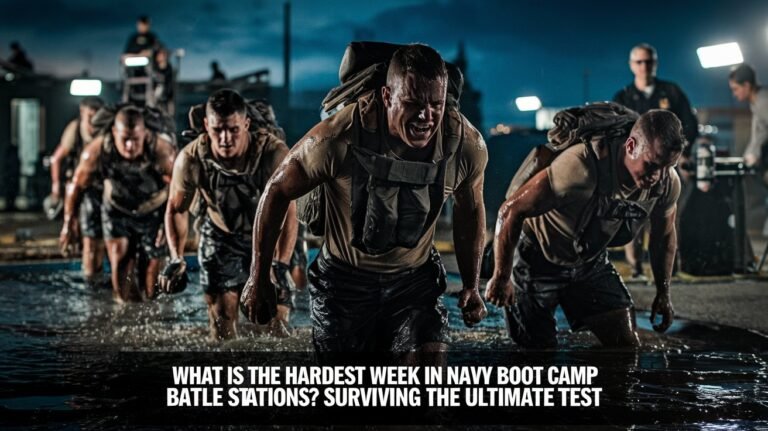Do You Run Inside Or Outside In Navy Boot Camp? Indoor and Outdoor Training

Running is key in navy boot camp. It’s part of the physical fitness test, along with push-ups and curl-ups. Since 2020, recruits can choose between running, biking, or rowing. This gives them more options for their training.
Recruits have to run 1.5 miles as part of their test. Their score is based on three events. To pass, they need a score of 60 or more. Knowing the best places to train is crucial for success.
Indoor and outdoor running have their own advantages and disadvantages. Recruits need to think about these when picking where to train. This choice can greatly affect their performance in navy boot camp.
Physical Training Standards at Naval Boot Camp
At naval boot camp, recruits face tough physical training. This prepares them for naval service. The training includes push-ups, curl-ups, and running or swimming. Recruits can track their progress with test standards and a scoring system.
The training at boot camp tests fitness and endurance. A 1.5-mile run/walk shows cardio health. Push-ups and curl-ups check muscle strength. The test scores range from outstanding to failure.
Initial Fitness Assessment Requirements
The first test includes a 1.5-mile run, push-ups, and curl-ups. Recruits must finish these within set times. Younger recruits have tighter time limits than older ones.
Running Distance Requirements
The 1.5-mile run is a key test at boot camp. It checks cardio health. Recruits must finish the run within certain times, based on age.
Time Standards for Different Age Groups
Time limits vary by age at boot camp. For example, 17-19 year olds must run in 10:30 minutes or less. Those 20-24 must run in 11:00 minutes or less. Push-up and curl-up times also depend on age.
Do You Run Inside Or Outside In Navy Boot Camp
Navy boot camp is tough and requires top physical shape. Running is a key part of the fitness test. It can be done indoors or outdoors, depending on the weather, facilities, and training goals.
Recruits do both indoor and outdoor running. Indoor running on treadmills or tracks helps build endurance and speed. Outdoor running on various terrains like roads and trails builds strength and agility.
Indoor running has its benefits, such as:
- Climate control: It lets recruits run in a controlled environment, no matter the weather.
- Reduced risk of injury: Indoor surfaces are softer, making it safer for recruits.
- Increased accuracy: It’s easier to measure distance and speed indoors.
Outdoor running also has its advantages, like:
- Variety: It offers different terrains, including hills and trails.
- Scenic views: Outdoor running provides beautiful views and a break from indoor routines.
- Preparation for real-world scenarios: It prepares recruits for various terrains they might face.
| Type of Running | Benefits | Drawbacks |
|---|---|---|
| Indoor Running | Climate control, reduced risk of injury, increased accuracy | Limited variety, can be monotonous |
| Outdoor Running | Variety, scenic views, preparation for real-world scenarios | Weather dependence, increased risk of injury |
In conclusion, both indoor and outdoor running have their benefits and drawbacks in navy boot camp. The choice depends on the training goals and available facilities.
Indoor Training Facilities at Great Lakes
The Great Lakes training facility has top-notch indoor training areas, including the Freedom Hall track. It gives recruits a place to train, no matter the weather. The indoor spaces are set up to mimic outdoor settings, helping recruits get ready for all kinds of scenarios.
Some of the key features of the indoor training facilities at Great Lakes include:
- Climate controls to simulate different weather conditions
- Various surface types to mimic outdoor terrain
- Advanced equipment to monitor and track recruit performance
Freedom Hall Track Specifications
The Freedom Hall track is a top indoor training spot. It has advanced climate controls and surface types. Recruits can train in many conditions, from hot to cold. It’s a safe and tough place for recruits to test their limits.
Indoor Climate Controls
The indoor climate controls at Great Lakes let trainers control temperature, humidity, and more. This helps recruits get used to different conditions safely. It also lets trainers create various outdoor scenarios, perfect for training all year.
Surface Types and Impact
The surfaces at Great Lakes’ indoor facilities are like outdoor terrain. They help reduce injury risk and let recruits perform well. The surfaces are also grippy and stable, helping recruits do their best.
Outdoor Running Routes and Courses
Navy boot camp has outdoor running routes and courses to test recruits’ fitness. These paths vary in length and terrain, offering a full training experience. Recruits run on trails, roads, and tracks, boosting their endurance and agility.
The outdoor routes and courses are key to the training at Navy boot camp. They aim to push recruits to their limits, testing their physical and mental strength. Running outdoors exposes recruits to different weather, preparing them for various scenarios in their service.
- Outdoor running routes and courses at Navy boot camp include a mix of short and long distances, with some routes featuring hills and inclines to simulate real-world terrain.
- The courses are designed to be challenging, with the goal of improving recruits’ overall fitness and preparing them for the physical demands of naval service.
- Recruits can expect to run in formation, learning to work together as a team and build camaraderie with their fellow recruits.
The outdoor running routes and courses at Navy boot camp are vital for preparing recruits. They ensure recruits are ready for the physical and mental challenges of naval service. This comprehensive training program helps recruits become effective members of the Navy team.
Weather Impact on Training Locations
The weather greatly affects where and when recruits train. Knowing how weather impacts training is key. Recruits must adjust to different weather, which affects their health and mind.
Changing training plans with the seasons is vital. For example, in hot or cold weather, training times might change. This helps avoid illnesses or injuries.
Seasonal Training Adjustments
Training spots and times change with the seasons. This ensures recruits are ready for any weather. They might do shorter, less intense workouts in extreme weather. They also get extra safety help, like staying hydrated.
Safety Protocols During Extreme Conditions
There are safety steps to keep recruits safe in bad weather. They get the right clothes and gear. They also have access to medical help if needed.
| Weather Condition | Safety Protocol |
|---|---|
| Extreme Heat | Hydration and cooling systems, adjusted training schedules |
| Extreme Cold | Warm clothing and gear, adjusted training schedules |
| Rain or Thunderstorms | Rain gear, lightning safety protocols |
By understanding weather’s impact and using safety measures, recruits stay safe and perform well. This is true no matter the weather.
Performance Differences: Indoor vs Outdoor Training
Navy boot camp running shows big differences between indoor and outdoor training. Indoor training happens on a track or treadmill, offering a steady environment. Outdoor training, on the other hand, takes place in various settings like trails, roads, and hills. These places can be tougher and less predictable.
Several factors influence how indoor and outdoor training compare. These include:
- Climate: Weather like temperature, humidity, and wind affects outdoor training more.
- Surface type: Indoor training is on a smooth, flat surface. Outdoor training can be on different surfaces, like trails and roads.
- Distance: Outdoor training often covers longer distances and varied terrain, making it harder than indoor training.
A study shows that losing just 8% of body water can cut endurance times from 121 minutes to 55 minutes. This shows how important staying hydrated is, whether you’re training indoors or outdoors. Here’s a table that highlights some key points for both types of training:
| Type of Training | Climate | Surface Type | Distance |
|---|---|---|---|
| Indoor Training | Controlled | Smooth, flat | Shorter distances |
| Outdoor Training | Varied | Varied | Longer distances |
In summary, knowing the differences between indoor and outdoor training is key for Navy boot camp running. By looking at climate, surface type, and distance, you can tailor your training. This helps improve your performance.
Medical Considerations for Training Environments
Medical checks are key in training environments to keep recruits safe and healthy. The evaluation includes blood tests, hearing and vision checks, dental exams, and questions about health history. This detailed process helps spot health issues early and avoids injuries during training.
Preventing injuries is a big part of medical checks in training. Recruits do a lot of physical training, which can be tough. It’s important to think about the air and water quality and make sure the training area is safe and healthy.
Steps are taken to avoid injuries and keep the environment healthy. These include:
- Providing nutritious food options
- Offering access to specialty fitness programs
- Conducting regular health assessments
- Ensuring safe and healthy training facilities
By focusing on medical checks and injury prevention, training places can better support recruits’ health. This helps make physical training more effective and boosts military readiness.
| Medical Consideration | Training Environment | Injury Prevention | Environmental Health |
|---|---|---|---|
| Comprehensive medical evaluation | Safe and healthy facilities | Regular health assessments | Quality of air and water |
| Physical training | Nutritious food options | Specialty fitness programs | Waste management |
Training Schedule Variations
At navy boot camp, recruits face different training schedules. These schedules test their physical and mental limits. They prepare recruits for naval service demands.
The training schedule includes various exercises, drills, and simulations. Each is tailored to meet the needs of each recruit.
The navy boot camp training schedule is well-planned. It balances physical training, classroom lessons, and hands-on experience. The schedule changes based on the season, weather, and recruits’ progress.
In winter, recruits do indoor activities like swimming and weightlifting. In summer, they do outdoor activities like running and obstacle courses.
Training schedule variations at navy boot camp offer many benefits. They improve physical fitness and endurance. They also boost mental toughness and resilience.
Recruits gain confidence and self-discipline. They become better prepared for naval service challenges.
The training schedule variations are key to the recruitment process. They help develop the skills, knowledge, and character needed for naval personnel. The navy boot camp ensures recruits are ready for naval service demands.
| Training Activity | Frequency | Duration |
|---|---|---|
| Running | 3 times a week | 30-60 minutes |
| Swimming | 2 times a week | 30-60 minutes |
| Obstacle Course | 1 time a week | 60-90 minutes |
Equipment Requirements for Both Settings
Having the right equipment is key for training, whether indoors or outdoors. It’s important for both performance and safety. The right shoes are crucial, as they affect how well you can do. For example, good running shoes can prevent injuries and boost performance.
For indoor training, recruits need to bring towels, water bottles, and personal items. Outdoor training requires sunscreen, insect repellent, and more to protect against the elements. Knowing what you need for each setting helps you prepare and stay safe.
Proper Footwear Selection
Choosing the right shoes is vital for both indoor and outdoor training. Look for shoes made for your activity, like running or cross-training. They should fit well and offer support and cushioning. Brands like Nike, Adidas, and New Balance are popular for training shoes.
Required Training Gear
The gear you need changes based on where you train. Here’s a table showing common equipment for indoor and outdoor training:
| Equipment | Indoor Training | Outdoor Training |
|---|---|---|
| Footwear | Running shoes or cross-trainers | Running shoes or hiking boots |
| Clothing | Moisture-wicking clothing | Moisture-wicking clothing and sunscreen |
| Personal Items | Towels, water bottles | Water bottles, insect repellent |
Knowing what you need for indoor and outdoor training helps you prepare. The right shoes and gear are crucial for success and safety. They make a big difference in how well you perform and your overall experience.
Adaptation Strategies for Different Running Environments
Adapting to different running environments is key to performance. Each setting, like a track or trails, needs its own approach. This ensures the best results.
Understanding what affects adaptation is important. This includes where you train, the weather, and the surface. Knowing this helps develop strategies for each environment. Mixing indoor and outdoor training helps the body adjust.
Some key considerations for adaptation strategies include:
- Acclimatizing to different climates and temperatures
- Adjusting to varying surface types, such as tracks, trails, or roads
- Developing techniques for running in different weather conditions, such as rain or extreme heat
Implementing these strategies can boost performance and lower injury risk. Remember, everyone is different. What works for one might not for another. So, it’s important to try different approaches to find what works best.
The aim of adaptation strategies is to improve performance in various settings. By understanding what affects adaptation and using effective strategies, recruits can optimize their training. This helps them reach their goals.
Physical Readiness Test Preparation
Getting ready for the physical readiness test is key to doing well. The test has three parts: a 1.5-mile run, a push-up test, and a sit-up test. To get ready, you should do cardio, strength training, and stretch. Running three times a week is also important.
Both indoor and outdoor training are good. Indoor training lets you control the environment and measure things accurately. It also lowers the chance of getting hurt. Outdoor training, though, gets you used to real-life situations and can be tougher. Mixing both kinds of training helps you prepare better for the test.
Benefits of Indoor Training
- Controlled environment for precise measurements
- Minimized risk of injury
- Access to specialized equipment and facilities
Advantages of Outdoor Training
- Prepares individuals for real-world conditions
- Can be more challenging and engaging
- Allows for variation in terrain and climate
Combining indoor and outdoor training, along with physical and mental prep, can lead to success in the physical readiness test.
| Training Type | Benefits |
|---|---|
| Indoor Training | Controlled environment, minimized risk of injury |
| Outdoor Training | Prepares for real-world conditions, can be more challenging |
Conclusion
Looking back at Navy boot camp running, we see both indoor and outdoor training have their perks. Recruits can choose the controlled indoor spaces or the natural outdoor paths. The important thing is to be dedicated and flexible in each setting.
Being good at both shows a recruit’s strength in body and mind. They learn to run well indoors and outdoors. This skill helps them meet the Navy’s high fitness standards and prepares them for naval life.
The Navy keeps working to make its training better. But one thing stays the same: its dedication to making sailors strong and capable. By facing the challenges of different training places, recruits become true examples of the Navy’s values: “Honor, Courage, and Commitment.”
FAQ
What are the physical training standards at Naval boot camp?
At Naval boot camp, recruits face a fitness test at the start. They must run certain distances and meet time goals based on their age. These standards help them pass boot camp.
Do Navy recruits run inside or outside during boot camp?
Recruits run both inside and outside, depending on where they are and the weather. The Navy considers safety and the environment when deciding where to run.
What are the indoor training facilities like at Great Lakes?
Great Lakes has a track called Freedom Hall for indoor training. It has specific features and a controlled climate. This setup helps prepare recruits for their training.
What are the outdoor running routes and courses like at Navy boot camp?
Navy boot camp has many outdoor routes and courses. They vary in distance and terrain. Outdoor training adds a different challenge for recruits.
How does the weather impact training locations at Navy boot camp?
Weather greatly affects where recruits train at Navy boot camp. The Navy adjusts training to keep recruits safe in extreme weather.
What are the performance differences between indoor and outdoor training?
Indoor and outdoor training have their own benefits and challenges. The location, climate, and surface type can affect performance. Both types of training are important for recruits.
What medical considerations are taken into account for training environments?
The Navy focuses on preventing injuries and keeping recruits healthy. They consider environmental factors to ensure safety during training.
How do the training schedules vary at Navy boot camp?
Training schedules at Navy boot camp change based on several factors. Recruits may face different schedules during their training.
What equipment is required for both indoor and outdoor training at Navy boot camp?
Recruits need the right shoes and gear for both indoor and outdoor training. The right equipment helps them perform better and stay comfortable.
How do recruits adapt to different running environments at Navy boot camp?
Recruits learn to adapt to various running environments. They must consider factors like location, climate, and surface type. This helps them succeed in both indoor and outdoor training.
How do recruits prepare for the physical readiness test at Navy boot camp?
Recruits prepare for the physical readiness test through a mix of indoor and outdoor training. They focus on the benefits of each environment to meet their goals.






